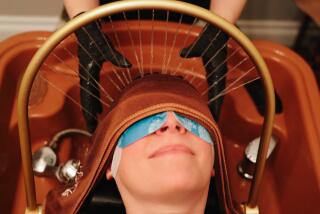Pain Relief’s the Point of Acupuncture
- Share via
B is an active, healthy 71-year-old adult male. Four years ago, he had triple bypass surgery, similar to the procedure David Letterman had recently. His surgery was successful except for a lingering burning and stinging pain along the incision in his left leg where a vein had been removed, sections of which would replace those that had failed in his heart.
Over the next few years, creams and lotions failed to ease the pain, which sometimes kept him awake at night. The surgeon suggested plastic surgery to try to remove the cause of the pain, probably a nicked nerve. But more surgery had little appeal. When a friend suggested acupuncture, Bill was skeptical. He checked the Internet and consumer-oriented health publications, and found that Americans are using acupuncture increasingly to relieve migraine headaches, nausea and pain.
Bill made an appointment with a licensed acupuncturist who was also a physician. He put on a gown and lay down on a treatment table. The room lights were dim, the table warm. The acupuncturist methodically placed about a dozen acupuncture needles at specific points in his leg. Bill felt no discomfort as the thin, disposable needles were inserted along his lower leg.
The doctor told Bill to relax and enjoy the restful music that gently filled the room. He dozed off. After 45 minutes, the doctor removed the needles and asked Bill to return for a second treatment in two weeks.
The intense pain gradually began to dissipate, but enough remained to warrant keeping the next appointment. After that second session, the pain disappeared. Now, more than six months and no additional treatments later, it has not returned.
Did the acupuncture really work or was it a placebo effect?
There is increasing evidence from scientifically valid studies around the world of the physiological effect of placing needles in muscles and fibers of the body. Researchers are finding that acupuncture does interrupt messages on their way to pain identification centers in the midbrain and elsewhere.
Acupuncture is perhaps the most widely accepted alternative therapy among mainstream practitioners for the management of certain types of pain and for addiction control. It is used in many hospitals and clinics. A University of Maryland study estimates that 1 million Americans use acupuncture annually to treat pain and other problems.
Developed more than 2,000 years ago as a cure for all ills, acupuncture remains a basic component of traditional Chinese medicine. Intensive study is required before a practitioner can apply it with maximum effect. Bill’s acupuncturist studied for 12 years in China, learning the hundreds of acupuncture points and their relationship to specific pain or injury before she returned to practice in the United States.
Modern investigation seems to support the idea that each acupuncture point or the channel on which it is located connects to a spinal cord and brain pathway. The insertion of a needle in the right place, sometimes far distant from the source of the pain, apparently stimulates small nerves in muscles that are pathways to and around the brain.
After more than 20 years of research, it is believed that these needle interruptions cause biological responses, such as the release of “transmitter chemicals” that block transmission of pain messages from their source. Modern testing methods document acupuncture’s effects, and research continues to provide solid evidence about its effectiveness.
Although thousands of anecdotal reports of success have accumulated over the years in the U.S. and around the world, it is only recently that serious Western research has addressed the utility of this technique. Although many studies show benefits, not all produce positive results. Some research, for example, fails to support the utility of acupuncture for smoking cessation, asthma and some types of pain.
However, studies in Germany and Sweden found that acupuncture diminished disability and low back pain, and other research documented the effectiveness of acupuncture in treating dental pain, nausea and vomiting, and migraine headaches. The U.S. National Institutes of Health concluded that acupuncture may also be a useful supplementary treatment for addiction, stroke rehabilitation, headache, menstrual cramps, tennis elbow, fibromyalgia, myofascial pain, osteoarthritis, low back pain, carpal tunnel syndrome and asthma.
Acupuncture therapy is not without some risk, although adverse effects appear to be minimal and uncommon.
What’s the bottom line for the consumer? Evidence to date indicates that acupuncture is generally safe and painless. Treatments are relatively brief but need to be repeated several times. Acupuncture appears to effectively reduce pain caused by a variety of conditions. If you decide to try it, ask your doctor to obtain recommendations for a licensed, certified, well-trained acupuncturist.
Despite the growing body of scientific evidence about acupuncture’s benefits, some skeptics say that acupuncture produces only a placebo effect. If it works, what would be wrong with that? At the very least, we would have found a way to harness the great and elusive power of the placebo.
*
Barrie R. Cassileth is chief of integrative medicine at Memorial Sloan-Kettering Cancer Center in New York and the author of “The Alternative Medicine Handbook” (Norton, 1998). Her column appears the first Monday of the month.





